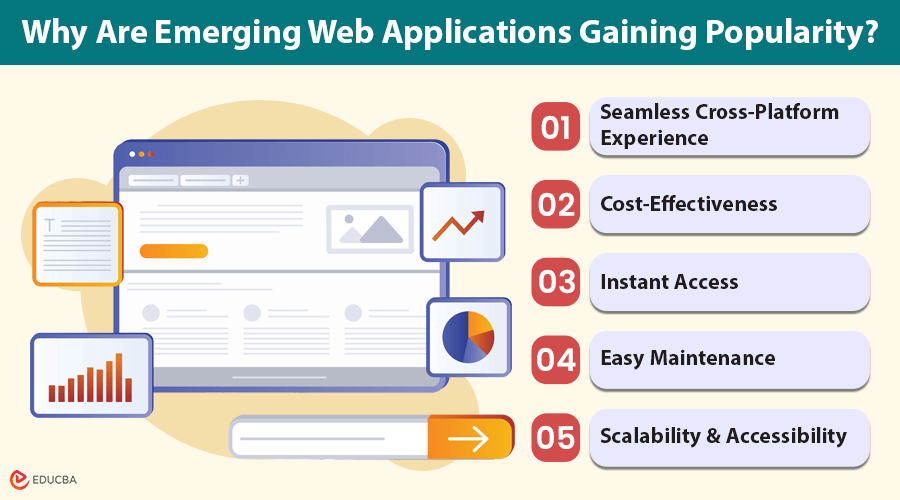
How Emerging Web Applications Are Transforming Mobile App Development?
The way we interact with technology is undergoing a significant transformation, and one of the biggest shifts is happening in the world of software development. Thanks to their cost-effectiveness, ease of use, and platform independence, emerging web applications are steadily replacing traditional mobile applications. These advancements are setting new benchmarks in how businesses and users approach app development and usage.
Why Are Emerging Web Applications Gaining Popularity?
Following are the reasons for why emerging web application gaining popularity:
1. Seamless Cross-Platform Experience
Emerging web applications work effortlessly on any device with a browser. Whether it is a smartphone, tablet, or desktop, users enjoy the same experience without needing to download or install anything. This eliminates the need for separate versions for iOS and Android, making them more efficient and user-friendly.
2. Cost-Effectiveness
Developing native mobile apps often requires separate teams for Android and iOS, significantly increasing costs. Web applications enable businesses to create one version that works on all platforms, saving time, reducing costs, and providing value.
3. Instant Access
Web apps require no installations. Users can access them instantly through a link and bookmark the page for future use. This removes concerns about updates, storage space, or compatibility issues.
4. Easy Maintenance
With web applications, updates happen on the server side. Users always get the latest version without having to update it manually. Businesses can also roll out fixes or improvements instantly without waiting for app store approvals.
5. Scalability and Accessibility
Developers design emerging web applications to scale seamlessly as demand grows. They are accessible on older devices and operating systems, ensuring inclusivity and future-proof functionality.
Challenges for Emerging Web Applications
Despite their many advantages, web applications face a few limitations:
- Limited Access to Device Features: Web applications, unlike native apps, might have limited access to hardware features such as cameras or Bluetooth.
- Performance in High-Demand Scenarios: Native apps often outperform web apps in resource-intensive tasks such as gaming or augmented reality.
- Browser Compatibility: Web apps need rigorous testing across multiple browsers to ensure consistent performance.
However, advancements like Progressive Web Applications (PWAs) are addressing these challenges. PWAs provide offline access, push notifications, and better performance, closing the gap between web and native apps.
Industries Embracing Emerging Web Applications
1. E-Commerce
Retailers are leveraging web applications to deliver seamless shopping experiences. Features like real-time inventory updates and fast checkouts make online shopping more efficient and enjoyable.
2. Education
Emerging web applications are reshaping education by offering interactive platforms for video lessons, quizzes, and progress tracking. Their accessibility ensures students can learn from anywhere, on any device.
3. Healthcare
The healthcare industry is adopting web applications for patient management, telemedicine, and appointment scheduling. These tools make healthcare more accessible and streamlined for both providers and patients.
4. Business Tools
Web applications are becoming indispensable for businesses. For instance, Sheetcast is a tool that enables organizations to convert Excel spreadsheets into fully functional web applications. This innovative solution allows teams to digitize workflows without requiring advanced coding knowledge, simplifying the transition to modern business solutions.
What Does the Future Hold for Emerging Web Applications?
The future of emerging web applications looks incredibly promising. As technology evolves, web apps will become even more powerful, versatile, and user-friendly. Tools like Sheetcast are leading the way for businesses to transition from static spreadsheets to dynamic web apps, enabling teams to work smarter and more efficiently.
Native apps will likely continue to be essential for specific high-performance requirements. However, web applications are poised to lead industries that value accessibility, scalability, and cost efficiency. Sheetcast is at the forefront of this digital transformation, enabling seamless conversion of Excel to Web App.
Final Thoughts
Emerging web applications are rapidly becoming the preferred choice for businesses and users. Their ability to work across platforms, reduce costs, and simplify updates makes them a compelling alternative to traditional mobile apps. By adopting cutting-edge tools and technologies, organizations can fully exploit the potential of these applications to revolutionize their workflows and user experiences.
This shift is not just a passing trend—it is a fundamental change in how we approach software development. As more industries embrace this technology, the line between web apps and native apps will blur, ushering in a new era of accessible, scalable, and innovative digital solutions.
Recommended Articles
We hope this guide helps you understand the impact of emerging web applications. Explore these recommended articles for more insights on the future of app development.

